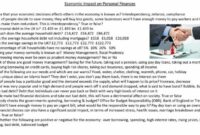Navigating career changes and transitions in today’s job market is a journey filled with both challenges and opportunities. The modern workplace is dynamic, constantly evolving with technological advancements and shifting industry demands. This exploration delves into the practical steps and strategic thinking required to successfully manage a career transition, from identifying your skills and interests to crafting a compelling personal brand and negotiating a competitive compensation package.
We’ll cover essential aspects like upskilling, networking effectively, and maintaining a positive mindset throughout the process, ultimately empowering you to confidently navigate this crucial phase of your professional life.
Whether you’re considering a complete career overhaul or a strategic pivot within your existing field, understanding the current job market landscape is paramount. This involves researching in-demand skills, exploring different industries, and leveraging online resources to enhance your professional profile. We’ll examine various job search strategies, from traditional methods to the power of online networking platforms like LinkedIn.
The goal is to equip you with the tools and knowledge to confidently pursue your desired career path and achieve your professional aspirations.
Identifying Career Change Needs
Navigating a career change can feel overwhelming, but understanding your motivations and assessing your skills is the crucial first step. Many individuals find themselves at a crossroads, questioning their current path and seeking a more fulfilling or sustainable career. This section will explore common reasons for career transitions and guide you through a self-assessment process to identify your aptitudes and interests.
Three common reasons individuals seek career transitions are dissatisfaction with their current role, a desire for greater work-life balance, and a need for increased income or career advancement opportunities. Dissatisfaction can stem from various factors, including lack of challenge, poor work environment, or a mismatch between skills and responsibilities. The pursuit of better work-life balance often reflects a desire for more flexibility, reduced stress, or a better alignment between professional and personal life.
Navigating career changes can be tough, requiring careful consideration of your values and priorities. For example, you might find yourself reevaluating your lifestyle choices, especially considering the impact of consumption. This leads to questions about the environmental cost, which is explored in detail on this insightful article about Luxury lifestyle and its environmental footprint.
Ultimately, a fulfilling career path often involves aligning personal values with professional goals, even influencing your consumption habits.
Finally, financial needs or career aspirations can drive individuals to seek higher-paying positions or roles offering greater professional growth.
Self-Assessment for Career Aptitudes and Interests, Navigating career changes and transitions in today’s job market
A thorough self-assessment is essential for identifying your strengths, weaknesses, and interests, which will inform your career choices. This process involves introspection, research, and potentially professional guidance. The goal is to create a clear picture of your skills, values, and aspirations, helping you to identify careers that align with your personality and capabilities.
The steps involved in conducting a comprehensive self-assessment include: First, reflect on your past experiences, identifying tasks and projects you enjoyed and excelled at. This can reveal underlying aptitudes and interests. Second, explore your skills and abilities. Consider both hard skills (technical abilities) and soft skills (interpersonal and communication skills). Use online skill assessments or seek feedback from colleagues and mentors.
Third, identify your values. What’s truly important to you in a job? Consider factors such as work-life balance, creativity, helping others, or intellectual stimulation. Fourth, research potential career paths that align with your identified skills, interests, and values. Explore job descriptions and talk to people working in fields that interest you.
Finally, consider seeking professional guidance from a career counselor or coach. They can provide personalized assessments and support throughout the process.
Resources for Career Exploration and Self-Discovery
Several resources are available to aid in career exploration and self-discovery. These tools provide valuable insights into different career paths, skills requirements, and salary expectations, helping you make informed decisions about your career transition.
Navigating career changes can be tough, especially with the current job market fluctuations. Smart financial planning is key, and sometimes that means re-evaluating your spending habits. Learning to prioritize and make the most of your resources is crucial, which is why understanding how to Maintain a luxury lifestyle on a modest income can be surprisingly helpful during a career transition.
This allows you to focus on your job search without unnecessary financial stress, ultimately leading to a smoother transition into your next role.
- Online Career Assessments: Websites like LinkedIn Learning, Coursera, and others offer various career aptitude tests and assessments that can provide insights into your strengths and potential career paths.
- Occupational Outlook Handbook (OOH): Published by the U.S. Bureau of Labor Statistics, the OOH provides detailed information on various occupations, including job duties, education requirements, salary expectations, and job outlook.
- Networking Events and Job Fairs: Attending industry events and job fairs allows you to connect with professionals in different fields, learn about their experiences, and gain valuable insights into potential career paths.
- Career Counseling Services: Many colleges, universities, and community organizations offer career counseling services that provide personalized guidance and support throughout the career exploration and decision-making process.
- Informational Interviews: Reaching out to individuals working in fields that interest you for informational interviews can provide valuable firsthand accounts of their work experiences, challenges, and rewards.
Assessing the Current Job Market
Navigating a career change requires a thorough understanding of the current job market. Different industries experience varying levels of growth and demand, influenced by technological advancements and evolving consumer needs. This section will analyze the job market landscape across several sectors, highlighting the impact of technology and identifying in-demand skills.
Comparison of Job Market Landscapes Across Three Industries
The tech industry, healthcare sector, and manufacturing sector represent vastly different job market landscapes. The tech industry is characterized by high growth, competitive salaries, and a constant demand for specialized skills. This is fueled by rapid technological advancements and the increasing reliance on digital solutions across all sectors. In contrast, the healthcare sector demonstrates consistent growth, driven by an aging population and advancements in medical technology.
However, this sector often faces challenges related to staffing shortages and regulatory complexities. Finally, the manufacturing sector is experiencing a period of transformation, with automation and robotics leading to job displacement in some areas while creating new opportunities in others, such as robotics engineering and data analytics. The overall growth rate in manufacturing is slower than in tech and healthcare, but specific niche areas within manufacturing experience significant demand.
Impact of Technological Advancements on Job Sectors
Technological advancements are reshaping the job market across various sectors. In the tech industry itself, the rapid evolution of artificial intelligence (AI), machine learning (ML), and cloud computing is constantly creating new roles and making others obsolete. For example, the demand for AI specialists and data scientists is exploding, while roles focused on manual coding tasks are becoming less prevalent.
Navigating career changes can be tough, especially with the rapid pace of technological advancements. Understanding emerging trends is key, and that includes looking at sectors like luxury lifestyles which are being heavily impacted by new tech. To get a better grasp on this, check out this insightful article on The future of luxury lifestyle and technological advancements.
This knowledge can help you identify new opportunities and make informed decisions about your career path in this evolving job market.
Similarly, the healthcare sector is undergoing a digital transformation, with telehealth, electronic health records (EHRs), and medical imaging technologies creating new roles in data management, software development, and remote patient monitoring. In manufacturing, the adoption of automation and robotics is transforming the production process, leading to increased efficiency but also to job displacement in areas like assembly line work. However, this also creates opportunities in areas like robotics maintenance, programming, and systems integration.
The overall impact of technology is creating a demand for workers with strong digital literacy, problem-solving skills, and adaptability.
In-Demand Skills Across Various Industries
The following table Artikels some of the most in-demand skills across various industries. These skills reflect the current trends and future needs of the job market. It is important to note that this is not an exhaustive list, and specific skills requirements will vary depending on the specific job and industry.
| Industry | Technical Skills | Soft Skills | Other In-Demand Skills |
|---|---|---|---|
| Technology | AI/ML, Cloud Computing, Cybersecurity, Data Analytics | Problem-solving, Communication, Teamwork, Adaptability | Agile methodologies, Software development, DevOps |
| Healthcare | Electronic Health Records (EHR), Telehealth, Medical Imaging | Empathy, Communication, Critical Thinking, Teamwork | Patient care, Medical coding, Regulatory compliance |
| Manufacturing | Robotics, Automation, PLC programming, IoT | Problem-solving, Teamwork, Adaptability, Safety awareness | Lean manufacturing, Supply chain management, Data analytics |
| Finance | Data analysis, Financial modeling, Risk management | Communication, Negotiation, Critical thinking, Problem-solving | Financial regulations, Compliance, Accounting |
Skill Development and Upskilling

Source: mirchi.in
Navigating a career change often requires acquiring new skills or enhancing existing ones to meet the demands of your target role. Upskilling and reskilling are crucial for remaining competitive in today’s dynamic job market, allowing you to demonstrate your adaptability and value to potential employers. This section explores resources for skill development and the advantages and disadvantages of pursuing further education.
Developing new skills and strengthening existing ones is a continuous process, particularly when changing careers. Focusing on both hard skills (technical abilities) and soft skills (interpersonal abilities) is key to a successful transition. Many resources are available to support this development, both online and offline.
Online Platforms and Resources for Skill Acquisition
Several online platforms offer diverse learning opportunities for career changers. Access to these resources can significantly impact the effectiveness and speed of skill development. Selecting the right platform depends on your learning style, budget, and the specific skills you need to acquire.
- Coursera: Offers a wide range of courses from top universities and organizations, many of which offer certifications upon completion. Subjects range from programming and data science to marketing and management.
- edX: Similar to Coursera, edX provides university-level courses, often with flexible learning options and a focus on practical application.
- Udemy: A marketplace for online courses, Udemy offers a vast library of courses covering various topics, often at more affordable prices than Coursera or edX. Quality can vary, so checking reviews is important.
- LinkedIn Learning: Integrated into the professional networking platform, LinkedIn Learning provides courses focused on career development and in-demand skills. It’s a convenient option for professionals seeking to enhance their profiles.
- Skillshare: Focuses on creative skills, Skillshare offers courses in areas like graphic design, video editing, writing, and illustration. It’s a good option for those looking to develop skills in creative fields.
Transferable Skills Across Diverse Professions
Many skills are valuable across various professions. Highlighting these transferable skills on your resume and during interviews can significantly improve your chances of landing a new role, even if your previous experience doesn’t directly align with the target position. These skills demonstrate your adaptability and potential.
Examples of transferable skills include:
- Communication (written and verbal): Essential in almost every profession, strong communication skills are highly valued by employers.
- Problem-solving: The ability to identify and solve problems effectively is crucial in any role.
- Teamwork and collaboration: Working effectively with others is vital in most work environments.
- Time management and organization: Efficiently managing time and tasks is essential for productivity.
- Adaptability and resilience: The ability to adapt to change and overcome challenges is increasingly important in today’s dynamic job market.
Benefits and Drawbacks of Further Education for Career Advancement
Pursuing further education, such as certifications or degrees, can significantly enhance career prospects. However, it’s crucial to weigh the benefits against the costs and time commitment involved. The decision should be based on individual circumstances and career goals.
Benefits: Increased earning potential, enhanced credibility, access to specialized knowledge and skills, improved career opportunities, and potential for career advancement.
Drawbacks: Significant financial investment (tuition fees, books, etc.), time commitment (potentially impacting current employment), opportunity cost (lost income during studies), and potential for limited return on investment if the chosen field doesn’t meet expectations.
Networking and Job Search Strategies

Source: amazonaws.com
Landing your dream job after a career change often hinges on a well-executed job search strategy that combines effective networking with a targeted approach to applications. This section Artikels key strategies to maximize your chances of success.Effective networking is crucial for uncovering hidden job opportunities and building relationships within your target industry. It’s not just about collecting business cards; it’s about cultivating genuine connections.
Networking Strategies within a Specific Industry
Building a strong professional network requires a proactive and strategic approach. Start by identifying key players and organizations in your desired field. This might involve attending industry events, joining relevant professional associations, or participating in online forums and communities. Actively engage in conversations, share your expertise, and offer help to others. Remember, networking is a two-way street; building relationships takes time and effort.
Consider informational interviews – reaching out to individuals in your target roles to learn about their experiences and gain insights into the industry. These conversations can lead to unexpected opportunities and valuable connections. Maintain consistent engagement with your network through regular communication and participation in industry discussions. Online platforms like LinkedIn can be powerful tools for connecting with professionals and expanding your network.
Crafting Compelling Resumes and Cover Letters
Your resume and cover letter are your first impression on potential employers. A generic application will likely be overlooked. Tailor each document to the specific job description, highlighting the skills and experiences most relevant to the position. Use s from the job posting throughout your resume and cover letter to ensure your application gets noticed by Applicant Tracking Systems (ATS).
Quantify your accomplishments whenever possible, using metrics to demonstrate the impact of your work. For example, instead of saying “Improved customer satisfaction,” say “Increased customer satisfaction scores by 15% through the implementation of a new training program.” A strong cover letter should personalize your application, showcasing your enthusiasm for the role and company. It’s your opportunity to tell your career story and explain why you’re a good fit for the specific position.
Traditional vs. Online Job Search Methods
Traditional job search methods, such as networking through personal contacts and responding to classified ads, still hold value, especially for niche industries or specialized roles. However, modern online platforms have revolutionized the job search landscape. LinkedIn, for example, allows you to connect directly with recruiters and hiring managers, showcase your skills and experience, and research companies and potential employers.
Job boards like Indeed and Monster offer a wide range of job postings, making them valuable resources for finding open positions. Online platforms offer broader reach and greater efficiency, allowing you to apply for numerous positions simultaneously. However, they also require careful management of your online presence and a strategic approach to applying for jobs. A balanced approach, combining both traditional and online methods, will significantly increase your chances of finding a suitable role.
For instance, networking at an industry conference might lead to an unadvertised opening, while simultaneously utilizing LinkedIn to connect with recruiters and apply for online job postings.
Managing the Transition Process
Navigating a career change is rarely a smooth, linear journey. It involves significant adjustments, both professionally and personally. Successfully managing this transition requires careful planning, resilience, and a proactive approach to address the challenges that inevitably arise. This section focuses on practical strategies for handling the financial, emotional, and mental aspects of your career shift.
Financial Planning for Career Transitions
A major concern during a career change is the potential disruption to income. Careful financial planning is crucial to mitigate this risk and ensure financial stability during the transition period. This involves creating a realistic budget, exploring potential income sources, and building an emergency fund.
- Create a Detailed Budget: Track your current income and expenses meticulously. Identify areas where you can cut back to reduce your spending and free up resources. This might involve reducing dining out, canceling subscriptions, or finding more affordable housing options.
- Explore Supplemental Income Sources: Consider freelance work, consulting gigs, or part-time employment to supplement your income while you search for a new role. Platforms like Upwork or Fiverr offer opportunities for freelancers in various fields.
- Build an Emergency Fund: Aim to save 3-6 months’ worth of living expenses in an easily accessible account. This financial cushion will provide a safety net during periods of unemployment or reduced income.
- Review your Savings and Investments: Assess your current savings and investments to determine if you can tap into any resources to support yourself during the transition. This might involve withdrawing from a retirement account (with careful consideration of any penalties).
- Seek Financial Advice: Consider consulting a financial advisor for personalized guidance on managing your finances during a career transition. They can help you develop a tailored plan based on your specific circumstances.
Maintaining a Positive Mindset
Maintaining a positive attitude is vital during a career transition. Doubt and anxiety are common, but focusing on your strengths, goals, and progress can significantly impact your overall well-being and success.
“Maintaining a positive mindset during a career transition is not about ignoring challenges; it’s about approaching them with resilience and a belief in your ability to overcome them.”
Regular self-reflection, celebrating small wins, and focusing on personal growth can help build and maintain a positive outlook. Connecting with supportive friends, family, or mentors can also provide valuable encouragement and perspective.
Stress and Anxiety Management
Career transitions often trigger stress and anxiety. Proactive strategies are essential to manage these feelings and maintain mental well-being.
- Practice Self-Care: Prioritize activities that promote relaxation and well-being, such as exercise, meditation, spending time in nature, or engaging in hobbies.
- Seek Support: Talk to trusted friends, family members, or a therapist about your feelings and concerns. Sharing your experiences can help alleviate stress and provide emotional support.
- Maintain a Routine: Establishing a consistent daily routine can provide a sense of structure and normalcy during a period of change. This includes regular sleep, healthy eating habits, and dedicated time for work-related activities.
- Set Realistic Expectations: Avoid putting undue pressure on yourself to find a new job immediately. Acknowledge that the job search process takes time and effort. Celebrate small victories along the way.
- Practice Mindfulness: Engage in mindfulness techniques, such as meditation or deep breathing exercises, to help manage stress and anxiety in the moment. Many free apps and online resources offer guided mindfulness practices.
Negotiating Salary and Benefits: Navigating Career Changes And Transitions In Today’s Job Market
Landing your dream job after a career transition is a fantastic achievement, but securing a competitive salary and benefits package is crucial to ensuring long-term job satisfaction and financial security. Negotiating this aspect can feel daunting, but with the right preparation and strategy, you can confidently advocate for your worth. This section will equip you with the tools and knowledge to navigate this important phase successfully.Negotiating salary and benefits involves a strategic approach that combines research, confidence, and a clear understanding of your worth.
It’s not just about the base salary; it’s about the entire compensation package. This includes factors such as health insurance, retirement contributions, paid time off, and other perks that contribute significantly to your overall financial well-being.
Researching Industry-Standard Salaries
Before entering any salary negotiation, thorough research is paramount. Several online resources provide salary data based on job title, location, experience level, and company size. Websites like Glassdoor, Salary.com, Payscale, and LinkedIn Salary provide aggregated data from employee submissions, offering a realistic picture of compensation in your target field and geographic area. For example, searching for “Software Engineer” in “San Francisco, CA” on Glassdoor might reveal a salary range of $120,000 – $180,000, depending on experience and specific skills.
Remember to consider the cost of living in your chosen location when evaluating salary offers; a $100,000 salary in a low-cost-of-living area might be equivalent to a $150,000 salary in a high-cost-of-living area. Always cross-reference data from multiple sources to get a comprehensive view.
Effective Negotiation Tactics
Effective negotiation requires a confident yet collaborative approach. Start by knowing your bottom line – the minimum salary and benefits you’re willing to accept. However, also research the market value of your skills and experience to determine your target salary – a figure that reflects your worth and aligns with industry standards. During the negotiation, present your case clearly and concisely, highlighting your skills, experience, and accomplishments relevant to the role.
Navigating career changes can be tough, requiring careful planning and a realistic assessment of your skills. Understanding your motivations is key, and sometimes that involves exploring deeper desires; for instance, consider how your aspirations align with the often-unconscious drivers discussed in The psychology of luxury lifestyle consumption. Ultimately, a successful transition hinges on self-awareness and a clear vision of your future career path.
For instance, you might say, “Based on my research and my ten years of experience in project management, coupled with my proven track record of delivering projects under budget and ahead of schedule, I believe a salary within the range of $130,000 to $140,000 is appropriate.” Be prepared to justify your request with concrete examples of your contributions.
If the initial offer is lower than your target, don’t immediately reject it. Instead, counter with your desired range, explaining why you believe your request is justified. Remember to listen actively and be open to compromise. A successful negotiation is a win-win situation.
Understanding Total Compensation
It’s crucial to consider the entire compensation package, not just the base salary. A lower base salary might be offset by generous benefits. For example, a comprehensive health insurance plan, a significant employer contribution to a 401(k) plan, and ample paid time off can significantly add to your overall compensation. Analyze the total value of the package, considering the cost of health insurance premiums, retirement contributions, and other benefits.
Don’t hesitate to ask clarifying questions about any benefits you’re unsure of. For instance, inquire about the specifics of the health insurance plan, the vesting schedule for the retirement plan, and the company’s policy on paid time off. By taking a holistic approach to compensation, you can make an informed decision that aligns with your financial goals and overall well-being.
Building a Personal Brand

Source: amazonaws.com
In today’s competitive job market, a strong personal brand is crucial for career advancement. It’s more than just a resume; it’s about crafting a compelling narrative that showcases your unique skills, experience, and value proposition to potential employers. This involves strategically presenting yourself online and offline to attract the right opportunities.Building a personal brand requires a conscious effort to define your strengths, identify your target audience, and consistently communicate your value proposition across various platforms.
It’s about showcasing your achievements and expertise in a way that resonates with recruiters and hiring managers. Think of it as marketing yourself as a valuable asset in the marketplace.
Crafting a Personal Brand Statement
A concise and impactful personal brand statement is the cornerstone of your professional identity. It should clearly articulate your unique skills, experience, and career aspirations. A well-crafted statement helps you communicate your value proposition quickly and effectively, making you memorable to potential employers.
Example: “Results-oriented project manager with 10+ years of experience leading cross-functional teams to deliver complex projects on time and within budget. Proven ability to streamline processes, improve efficiency, and exceed client expectations. Seeking a challenging leadership role in a dynamic and innovative organization.”
The Role of Online Presence in Career Advancement
Your online presence, particularly your LinkedIn profile, is often the first impression you make on potential employers. A well-optimized LinkedIn profile acts as your digital resume and networking hub, showcasing your skills, experience, and accomplishments to a wider audience. A complete and engaging profile demonstrates professionalism and increases your visibility to recruiters and hiring managers actively searching for candidates like you.
Regularly updating your profile with new skills, projects, and endorsements keeps your profile fresh and relevant.
Showcasing Accomplishments and Achievements
Simply listing your responsibilities isn’t enough. You need to demonstrate the impact you’ve made in your previous roles. Quantify your accomplishments whenever possible, using metrics and data to illustrate your contributions. Instead of saying “Managed social media accounts,” try “Increased social media engagement by 30% in six months, resulting in a 15% increase in leads.” This approach provides concrete evidence of your capabilities and value.
Highlighting your achievements in a compelling and engaging manner makes your profile stand out from the competition. Consider using the STAR method (Situation, Task, Action, Result) to structure your accomplishments effectively.
Closure
Successfully navigating a career change requires a proactive and strategic approach. By combining self-assessment, market research, skill development, and effective networking, you can significantly increase your chances of a smooth and successful transition. Remember, a positive mindset and resilience are key throughout the process. Embrace the learning opportunities, leverage your transferable skills, and confidently present your unique value proposition to potential employers.
The journey may present challenges, but with careful planning and a proactive attitude, you can confidently embrace the next chapter of your professional life.
Essential FAQs
What if I don’t have any transferable skills?
Everyone possesses transferable skills! Consider skills like communication, problem-solving, teamwork, and time management. These are valuable across various industries. Focus on highlighting how these skills apply to your target roles.
How long does a typical career transition take?
The timeframe varies greatly depending on individual circumstances, job search intensity, and the complexity of the career shift. It could range from a few months to over a year.
Should I quit my current job before securing a new one?
Generally, it’s advisable to secure a new position before leaving your current job, unless you have significant financial reserves. This minimizes financial risk and stress during the transition.
How can I deal with rejection during my job search?
Rejection is a common part of the job search process. View it as a learning opportunity. Analyze your application materials, refine your approach, and keep a positive outlook. Remember each “no” brings you closer to a “yes”.
What if I’m worried about the financial impact of a career change?
Carefully plan your finances. Create a budget, explore savings options, and potentially seek financial advice. Consider part-time work or freelance opportunities to supplement your income during the transition.





